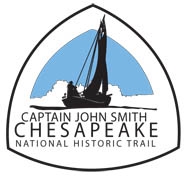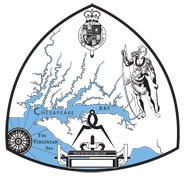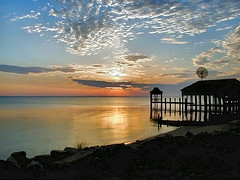

Come on a journey to remember and commemorate the history and travels of Captain John Smith!
Over four hundred years ago, Englishman John Smith and a small crew set out in an open boat to explore the Chesapeake Bay. Between 1607 and 1609 Smith mapped and documented nearly 3,000 miles of the Bay and its rivers. Along the way he visited many thriving American Indians communities and gathered information about this “fruitful and delightsome land.” In December 2006 the U.S. Congress designated the routes of Smith’s explorations of the Chesapeake as a national historic trail—the first national water trail.
Are you ready to follow in the wake of Captain John Smith? Visit sites along the National Historic Trail and learn about the native cultures and the natural environment of the 17th-century Chesapeake through the Captain John Smith Chesapeake Geotrail. The Trail provides opportunities for you to experience the Bay through the routes and places associated with Smith’s explorations. Caches will be located in museums, refuges, parks, and towns in Virginia, Maryland and Delaware along the rivers and creeks that Smith and his crew explored four centuries ago.
The Captain John Smith (CJS) Geotrail launched June 4, 2011 with over 40 caches within Maryland, Virginia and Delaware. A trackable geo coin will be awarded to the first 400 geocachers, while supplies last, for locating at least 15 CJS caches. To be eligible for the coin, geocachers must download a passport from either the CJS Geotrail or Maryland Geocaching Society website. Geocachers must find and log at least 15 finds, record the code word from each cache on their passport and post a picture of themselve at each cache location. After discovering the 15 required caches, geocachers may have thier passports validated in person or via mail at the National Park Service, Chesapeake Bay Office located at 410 Severn Ave, Suite 314, Annapolis, MD 21403. Please refer to the passport for complete validation instructions.
Participating in the CJS geotrail is fun and we hope that many people join in. However, it is not a requirement for logging your find on this cache once you find the container.

Please no night caching and adhere to all park rules. There is an entrance fee for this park. The park extends about one and a half miles along the Potomac River, and its 1,311 acres neighbor the former homes of both George Washington and Robert E. Lee. The park’s Horsehead Cliffs provide visitors with a spectacular view of the Potomac River. In addition to the scenic beauty at Westmoreland, the park offers hiking, camping, cabins, fishing, boating and swimming. Visitors can enjoy the park’s vacation cabins as well. The visitor center, open during summer, gives an informative historical and ecological perspective to an important natural area on the coastal plain.
Hike, fish, boat, kayak, bird watch, swim or search for fossils at this 1,311-acre park on the banks of the Potomac River. Westmoreland State Park offers guided walks, nature, history and kayaking programs, as well as festivals and workshops. The park also has a visitor center, gift shop, snack bar and a boathouse that sells gas, ice, bait and other fishing supplies. Paddleboats and rowboats are available for rental. The park extends about one and a half miles along the Potomac River, and it neighbors the George Washington Birthplace National Monument and Stratford Hall, birthplace of Robert E. Lee. The park’s Horsehead Cliffs provide visitors with a spectacular view of the Potomac River. The visitor center, open during summer, gives an informative historical and ecological perspective to an important natural area on the coastal plain.
Westmoreland State Park is one of the six original Virginia state parks opened in June 1936. The park was built in the 1930s by the Civilian Conservation Corps (CCC). The project created numerous jobs during a period of great hardship. Most of the roads and trails found in the park were originally dug by hand.
In June and July 1608, Captain John Smith and fourteen of his fellow Englishmen explored the Potomac River. Early in this leg of the Chesapeake voyage, probably at the Indian town of Onawmanient on the south bank near Nomini Bay, the English met a Wiccocomico Indian named Mosco. Unlike most Indians, Mosco had a fairly heavy beard which indicated European ancestry. Smith wrote in his journal, “Here we encountered . . . Mosco, a lusty savage of Wighcocomoco upon the River of Patawomek. We supposed him some Frenchman’s son because he had a thick black bush beard and the savages seldom have any at all – of which he was not a little proud to see so many of his countrymen.” Mosco stayed with the English for a portion of the Potomac River exploration and smoothed the way for a friendly reception for them on their return downstream.
Captain John Smith and his fellow English settlers at Jamestown were not the first Europeans to explore the Chesapeake and tributary rivers. England’s rival for colonial expansion was Spain. These two colonial powers competed to establish settlements in America, earn profits on exploitable resources, and find a quicker water route to China, a “shortcut” to lucrative trade markets. Before the English arrived in the Chesapeake, Spanish explorers had already visited, naming it “Bahia de Santa Maria”, and claimed the Chesapeake as part of its North American territory “La Florida”.
The earliest visit to the Chesapeake by Europeans may have been in 1524 by Giovanni di Verazzano. By 1572, the Spanish had explored and named the Bay, set up a Jesuit mission, and retaliated for the destruction of the mission. In the 1580’s, English from the ultimately failed colony at Roanoke stayed for several months with a Chesapeake tribe. In 1588, a Spanish military reconnaissance from Havana was on the Potomac River and in 1603 an unidentified European ship visited Werowocomoco and the Rappahannock.

Thanks to Vaetanone for helping with this hide and to the Maryland Geocaching Society for assisting with this project!